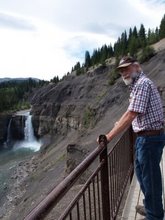Opinion by Helge Nome
Clearwater County, in the west-central part of Alberta is in the final stages of coming up with a Municipal Development Plan to guide future development within county boundaries. During this process, which has been going on for many months, a number of public consultation meetings have been hosted by county staff and elected councillors to solicit public opinion on the content of the plan as it has evolved under the hand of the hired consultant and county planning staff.
The contentious issue that has emerged is the creation of rural acreages in what are traditional farmland areas. During the real estate boom in recent years multiple subdivisions have come into being, both on a large concentrated scale and scattered smaller ones all the way down to individual parcels subdivided out of farm quarter sections (for overseas readers: A quarter section is about 160 acres on average).
As it turns out, both traditional rural residents and those that have moved from big cities to settle in the country on these acreages are beginning to react to the ever increasing number of subdivisions created while at the same time realizing financial gains from the process.
The outcome to date is a slightly bewildered county council trying to make sense of all the feedback, some of which has been quite acrimonious. One irritant has been the party crowd coming into the west country on holiday weekends, leaving a legacy of beer cans/bottles and bush tracks churned up by powerful quads, though these are hardly the same people that buy land and settle in the county.
The existing land use policy allows anyone to take one parcel out of an undivided quarter, adding some $150,000 to the land value of that quarter. This policy was originally intended to allow an elderly farming couple to retire in their own home by subdividing off the house and yard and sell the remaining farm lands as a retirement nest egg.
Recently, I heard about a speculator buying many quarters just so that he could take this traditional one-parcel-out and make a mint on this transaction without lifting a finger higher than a computer keyboard.
Perhaps this is where things have gone wrong: Land has been turned into a faceless commodity, just like most else in this world. The real durable value of the land has been forgotten in the head over heel chase after the dollar itself, which is deemed to be of supreme value. The result is the fragmentation of potentially productive land into increasingly useless parcels creating a rural sprawl, akin to the urban sprawl around big cities. Is this really what we want, just to be able to create numbers in computers that are supposed to represent wealth?
We need to take a new (old) look at land and regard it as our heritage rather than a commodity.
Monday, May 24, 2010
Subscribe to:
Post Comments (Atom)

No comments:
Post a Comment